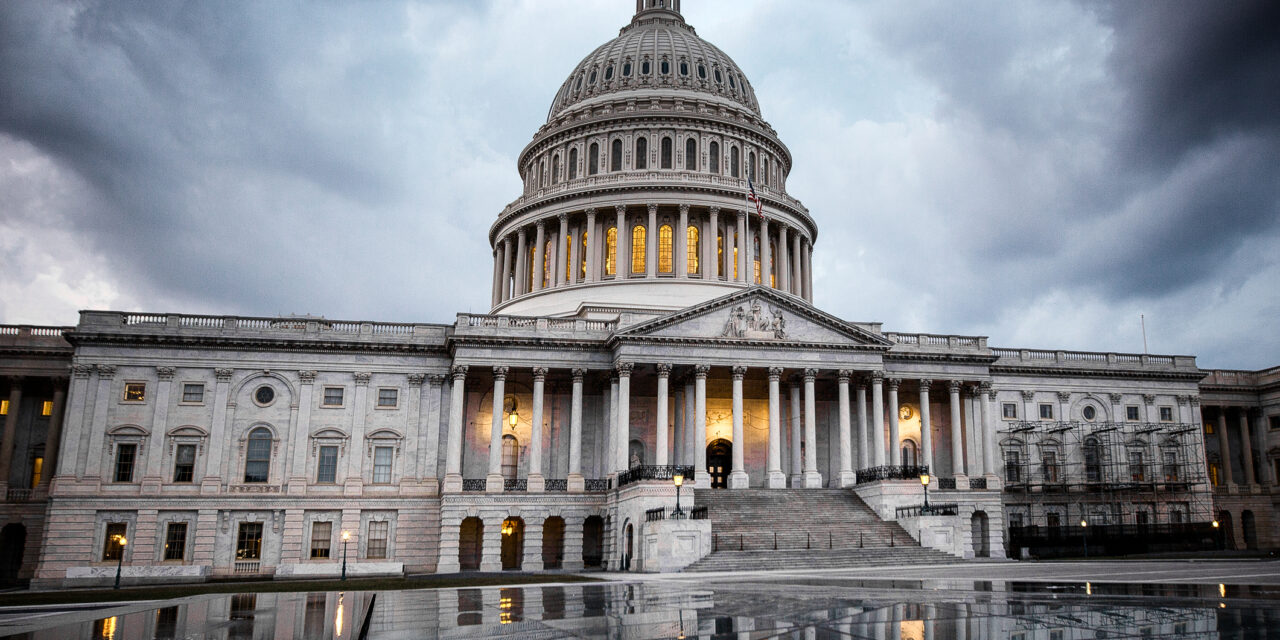It’s finally happened. The issue that’s been simmering for years has at long last boiled over into the collective consciousness. Starting with 300,000 marching in Chicago two weeks ago, and now culminating in what seems to be a daily flood of images from around the country of thousands taking to the streets, the American people and media are just now waking up and examining an issue that has the potential to not only change the political landscape of the country, but the very makeup of the nation itself. The legislation now being debated in the Senate would not only change the lives of millions of immigrants, legal and illegal, who live and work in this country – it could effect the lives of every American.
If done correctly immigration reform could bring millions of people out of the shadows, free from exploitation and fear. It could allow them to compete freely in the open market, demanding fair and just working condition and wages, and give them the opportunity join the greater society on a whole in the quest for a better life.
On the other hand, if done incorrectly, immigration reform could further divide this nation. It could force millions of immigrants to go further underground, criminalizing them and limiting the few opportunities they have to make a better life. It could further divide our nation along class and racial lines, and leave us with a permanent under-class of people with no hope of ever attaining legal status.
Before looking at the different legislative proposals that will be debated, and where we should be going, we need to look at where we are right now as far as immigration is concerned.
The Current Law: How does it work
All immigration is based upon the quota system. Each year the US Citizenship and Immigration Services issues Permanent Resident Cards (green cards) to four major categories of applicants:
- Immediate family members: spouses and minor children of US citizens, ( the number issued is unlimited and not effected by quotas)
- Family-based immigration: family members of permanent residents ,limit of 226,000 annually
- Employment-based immigrants: limit of 140,000 annually
- Diversity Lottery: 50,000 green cards distributed by lottery to those from nations with low rates of immigration to the US
Besides these major groups there are green cards issued for various other reasons such as those for refugees and those from specific counties such as Cuba, Haiti, Nicaragua.
The Employment based green cards are further divided up by categories based upon skill and educational levels. Out of the 140,000 cards issued, only 5000 go to un-skilled workers annually.
In addition to these quotas that limit the number of people who can apply in any given year for a green card by category, there is a second quota system in place. This second quota limits the number of people who can migrate from any one country. The per-country quota states that no single country can send more than 7% of the total worldwide immigration in any given year. In effect this system favors those from small countries that traditionally send few immigrants. A large country like China or India with a billion people or one with close proximity like Mexico or Canada that have traditionally had close economic and social ties to the US, receive the same number of green cards as Lichtenstein or Nauru with a population of approximately 10,000 people.
In the end it becomes evident that the current quota system sets up substantial barriers to those wishing to immigrate legally. If someone does not have family already in the country, come from a small country that traditionally sends few immigrants, or has substantial skills and education, the chances of entering the immigration system legally are minute. This is why as many people enter the US illegally each year as do legally. They are essentially shut out of the system from the start. The idea that all immigrants who want to come to the U.S can “do it the right way” and apply for legal entry, and that those who don’t just want to “cheat the system” and move to the “front of the line” is simply untrue.
Undocumented Immigrants: Who Are They?
What follows is the information from the executive summary of the current Pew report, “Size and Characteristics of the Unauthorized Migrant Population in the U.S.” The entire report can be read here.
Analysis of the March 2005 Current Population Survey shows that there were 11.1 million unauthorized in the United States a year ago. Based on analysis of other data sources that offer indications of the pace of growth in the foreign-born population, the Center developed an estimate of 11.5 to 12 million for the unauthorized population as of March 2006.
Size and Characteristics of the Unauthorized Migrant Population
Estimates Based on the March 2005 Current Population Survey
- Since 2000, growth in the unauthorized population has averaged more than 500,000 per year. Based on evidence that this trend has persisted, the current unauthorized population can be estimated at between 11.5 and 12 million.
- In the March 2005 estimate two-thirds (66%) of the unauthorized population had been in the country for ten years or less, and the largest share, 40% of the total or 4.4 million people had been in the country five years or less.
- Unauthorized migrants accounted for 30% of the foreign-born population in 2005. Another 28% were legal permanent residents, and 31% were U.S. citizens by Naturalization
- Most of unauthorized migrants came from Mexico. There were an estimated 6.2 million unauthorized Mexican migrants in 2005, or 56% of the unauthorized population.
- About 2.5 million unauthorized migrants, or 22% of the total, have come from the rest of Latin America, primarily from Central America. Unauthorized migrants from Mexico and the rest of Latin America represented 78% of the unauthorized population in 2005.
- Between 2000 and 2005 the number of unauthorized migrants from Mexico increased by about 1.5 million. Other large increases occurred among unauthorized migrants from Central America (+465,000) and South and East Asia (+365,000).
Family Characteristics
- There were 5.4 million adult males in the unauthorized population in 2005, accounting for 49% of the total. There were 3.9 million adult females accounting for 35% of the population. In addition, there were 1.8 million children who were unauthorized, or 16% of the total.
- Among adults, males make up 58% of the unauthorized population while females make up 42%
.
- As of 2005, there were 6.6 million families in which either the head of the family or the spouse was unauthorized. These unauthorized families contained 14.6 million persons.
- Nearly two-thirds (64%) of the children living in unauthorized families are U.S. citizens by birth, an estimated 3.1 million children in 2005.
Labor Force Characteristics
- Unauthorized migrants accounted for about 4.9% of the civilian labor force in March 2005, or about 7.2 million workers out of a labor force of 148 million.
- Unauthorized workers are employed in a variety of occupations, although the distribution of the unauthorized workforce across occupations differs from that of native-born workers. For example, nearly a third (31%) of
unauthorized workers were employed in service occupations compared to one-sixth (16%) of native workers in March 2005. Unauthorized migrants are underrepresented in white-collar occupations.- About 19% of unauthorized workers were employed in construction and extractive occupations, 15% in production, installation and repair and 4% in farming.
- Unauthorized migrants make up a large share of all workers in a few more detailed occupational categories. They were 24% of all workers employed in farming occupations, 17% in cleaning, 14% in construction and 12% in food preparation industries. Within those categories, unauthorized workers were a very large share of all workers in certain specific occupations. For example,
the unauthorized were 36% of all insulation workers and 29% of all roofers and drywall installers, 27% of all butchers and other food processing workers.- The concentration of unauthorized workers in broad industries is not as marked as the concentration in broad occupation groups. Only in “leisure & hospitality” and in “construction” does the share of unauthorized workers greatly exceed the share of natives. About 1 in 5 unauthorized workers was in the construction industry (20%) and 1 in 6 was in the leisure & hospitality
industry (17%). Only about 7%-8% of native workers was in each of these industries.- There are fewer detailed industries with high concentrations and significant numbers of unauthorized workers than detailed occupations. Nonetheless, there are some industries with substantial concentration of unauthorized workers. The unauthorized were 21% of the workers in private household industries. They were between 12% and 14% of all the workers in food manufacturing, farming, furniture manufacturing, construction, textiles, and food services.
THE LEGISLATION
As of today it appears that there are two major schools of thought on immigration reform:
Those that favor “enforcement only” proposals that favor the stiffening of criminal penalties for both undocumented immigrants and those who hire them, and increasing security at the border to try to prevent the flow of illegal immigration. They believe that if the climate that fosters illegal immigration were changed it would stop and we need to try to stop the flow immigrants at the border by building barriers both physically and through law enforcement.
A second school of thought are those supporting “comprehensive immigration reform” who believe that in order to control immigration the system needs to changed and accommodations must be made to make the immigration process easier. They believe that if the system allowed for more “legal” immigration there would be far less need for those who wish to come here to make a better life to do so “illegally”. That if immigrants could live and work legally in the country many if not all of the problems caused by illegal immigration would be eliminated.
These two schools of thought can be seen in the competing legislation now being debated.
Enforcement Only Bills
The “enforcement only” advocates have lined up behind the bill passed in the House in December sponsored by Representatives Sensenbrenner (R-WI) and King (R-NY); the “Border Protection, Antiterrorism and Illegal Immigration Control Act of 2005” (HR4437) and it’s Senate equivalent the “Securing America’s Borders Act” ( S.2454) put forward by Sen. Bill Frist (R-TN).
Although Frist’s bill varies slightly from HR4437 both bills would:
- Increase security forces and surveillance along the border and the building of a 700 mile long wall along the southern border.
- Give the power to immigration officials within 100 miles of the border to expel without a hearing anyone believed to be a recently arrived illegal immigrant.
- Expand mandatory detention to apply to all non-citizens arriving at a port of entry or “along” the border.
- Limit the basic rights of immigrants to judicial review, even by the constitutionally guaranteed writ of habeas corpus.
- Criminalize all violations of immigration law, even if the violation was unintentional or the result of processing delays
- Give additional powers to detain non-citizens indefinitely without judicial review, potentially placing many non-citizens in a legal black hole that subjects them to a life sentence after having served a criminal sentence, or, in some cases, without ever having been convicted of a crime.
“Expedited Removal”: Deportation Without a Lawyer, Hearing, Or Court Review
Expedited removal under current immigration laws is applied to non-citizens arriving at airports with apparently improper documents, to un-documented non-citizens arriving by sea, and a few other narrow categories of non-citizens. Basically, if you show up at JFK without paperwork, you are put on the next plane back without having any sort of hearing or review.H.R. 4312 will expand on the policy of “expedited removal,” and grant powers to even low-level immigration officers to remove individuals anywhere along the border. It would require the border patrol to pick up and deport, without any administrative hearing, anyone within 100 miles of the border that an agent thinks is an undocumented immigrant who has been present less than 14 days. How the officers are to determine the legal status of the deportees is not addressed in the legislation. The de facto result of this legislation is that anyone within 100 miles of the border (north or south) who is suspected of being here illegally could by deported without any sort of hearing or reviews.
Mandatory Detention
Under current law, individuals who arrive without documents, including asylum-seekers, are subject to mandatory detention. Again this applies mainy to those arriving at airports or by sea. 60% of detainees are held in local jails under contract to the federal government, where they are generally not segregated from the criminal population even if they are asylum-seekers and others with no criminal record.Under this new bill, the mandatory detention policy would be extended to all non-citizens who are detained at any port of entry or anywhere “along” the border for any reason.
“Illegal Presence” and “Aggravated Felonies,”
Section 203 of HR 4437 calls for the creation of a new federal crime of “illegal presence”. As defined in the bill it includes any violation, even technical, of any immigration law or regulation. Even if the immigrant was to fall “out of status” unintentionally, or do to paperwork delays. In essence, the bill makes every immigration violation, however minor, into a federal crime. As drafted, the bill also makes the new crime of “illegal presence” an “aggravated felony” for immigration purposes. This classification would have the further effect of restricting ordinary undocumented immigrants (including those with pending applications) from many forms of administrative or judicial review. Those convicted of an “aggravated felony” would be subject to indefinite detention and/or expedited removal.Indefinite Detention
Indefinite detention currently applies to non-citizens ordered removed from the United States whose countries refuse to accept them or who have no country because they are stateless. Most often they come from countries without good relations with the United States.HR 4437 would permit indefinite detention of an increased broad class of non-citizens, including:
- those with a contagious disease
- any non-citizen convicted of an “aggravated felony,” (see above)
- non-citizens whose release would pose foreign policy problems
- non-citizens charged even with very minor immigration violations who, based on secret evidence, are deemed a national security risk.
The bill also includes provisions to “combat the hiring of illegal workers”
The bill calls for an employment eligibility verification system in which employers will check the Social Security numbers and alien identification numbers provided by employees against Social Security Administration and Department of Homeland Security (DHS) records in order to weed out fraudulent numbers and ensure that their employees are not working in the U.S. illegally. The system is modified from a voluntary pilot program currently in use. The bill also increases civil and criminal penalties for knowingly hiring or employing an illegal worker.
Perhaps one of the most controversial aspects of the legislation is Sec. 202 of HR 4437 which in effect makes it a crime to “assist” in any way someone who is in the country illegally. It is this provision that has raised so much concern from humanitarian groups, doctors, lawyers and church officials. Although proponents of the bill assure that the measure would not be aimed at humanitarian workers, most remain skeptical. Sen. Frist’s version raises further concerns since he seemed to address the issue by making a provision for the church to allow for an “alien who is present in the United States to perform the vocation of a minister or missionary for the denomination or organization in the United States” and decimalized the giving of “emergency humanitarian assistance, including emergency medical care and food, or to transport the alien to a location where such assistance can be rendered”. While appearing to be a capitulation to humanitarian workers, Sec. 274 a 3, still furthers the restrictions that concern most of the groups involved by limiting it’s waver of criminality to “emergency assistance” only and to the recruitment of clergy.
One of the biggest criticisms of all the “enforcement only” legislation is that they make no provisions for the 12 million immigrants already in the country. These bills assume that if they make the penalties harsh enough, millions of immigrants will simple back up and go home. When asked about what would happen to the 12 million undocumented immigrants if new legislation was to pass, chief spokesmen for the enforcement only approach to immigration reform, Rep.Tom Tancredo (R- CO.) flippantly replied; “adios”. But as Sen. Lindsey Graham (R-SC) said yesterday in the Senate Judiciary deliberations, “what is home, where is home for these people?”…for many undocumented immigrants the US is home … home is where they have lived and worked for ten or twenty years … where they have married and raised their children. The enforcement only proponents simply make no account for that situation.
Comprehensive Immigration Bills
Essentially the bill that will go to the floor of the Senate today is the Senate Judiciary Committees “Chairman’s Mark” of the “Comprehensive Immigration Reform Act of 2006” which now contians many of the provisions of the bill originally put forward by Senators Kennedy (D-MA) and McCain (R-AZ), the “Secure America and Orderly Immigration Act” (S.1033). We do not yet know the specific language of the bill (It will be published within a day or two), we do know that it contains these major provisions:
- Increased border security and cooperation with Mexico and Canada
- Creates a “virtual wall” of unmanned vehicles, cameras and censors to monitor the U.S.-Mexico border.
- Doubles the border patrol over five years adding 12,000 agents
- Provides a path to legalization and citizenship for the 12 mil undocumented immigrants as long as they pass security clearance, pay all back taxes, pay a criminal fine for breaking immigration laws, remain employed, have no criminal record, acquire a level of English proficiency, and eventually pass the civics section of the citizenship exam. Current illegal residents cannot begin to apply for legal status until all current immigration requests have been processed
- Creates a guest worker program that allows approximately 400,000 unskilled workers to come and work for up to six years. Additionally, after a certain amount of time the guest workers who qualify may apply for permanent residency.
- Doubles all current fines for employers who hire illegal workers
- Quotas will become adjustable according to a given formula
- The Department of Labor will maintain an updated Job Bank of willing employers looking for workers
- The inclusion of an agricultural provision that will allow 1.5 million agricultural workers to work in the US legally
- Redefines the “aggravated felony” language of HR4437 to exempt those already here from prosecution.
The DREAM program will be continued allowing children of undocumented immigrants who have graduated from high school to be allowed to apply to Colleges without having their parents immigration status taken into consideration
As previously noted, the exact wording of the bill will be available shortly so the specifics might change slightly.
The criticisms of this approach are many. Critics claim that providing a path to legalization is no more than an amnesty and that would be rewarding those who have broken the law. That guest workers provided business with a cheap source of labor while preventing US citizens access to valuable jobs. And that immigrants put undue stresses on our already taxed social services programs and unfairly compete for limited resources with those already at the bottom of the economic ladder.
What Happens Now
Whether this bill makes it to the floor and what happens after that is still to be seen.
…the plan was fiercely attacked by conservative Republicans who called it nothing more than an offer of amnesty for lawbreakers. It remained unclear Monday night whether Senator Bill Frist, the Senate majority leader, would allow the bill to go for a vote this week on the floor or would substitute his own bill, which focuses on border security. His aides have said that Mr. Frist, who has said he wants a vote on immigration this week, would be reluctant to move forward with legislation that did not have the backing of a majority of the Republicans on the committee.
Only 4 of the 10 Republicans on the committee supported the bill. They were the committee chairman, Senator Arlen Specter of Pennsylvania, and Senators Lindsey Graham of South Carolina, Mike DeWine of Ohio and Sam Brownback of Kansas. All eight Democrats on the committee voted in favor of the legislation.
The rift among Republicans on the committee reflects the deep divisions in the party as business groups push to legalize their workers and conservatives battle to stem the tide of illegal immigration. Mr. Specter acknowledged the difficulties ahead, saying, “We are making the best of a difficult situation.” But he said he believed that the legislation would ultimately pass the Senate and would encourage the millions of illegal immigrants to come out of the shadows.
“We do not want to create a fugitive class in America,” Mr. Specter said after the vote. “We do not want to create an underclass in America.”
“I think this represents a reasonable accommodation,” he said, referring to the divergent views on the panel. “It’s not a majority of the majority, but it’s a good number.”
-snip-
Any legislation that passes the Senate will have to be reconciled with the tough border security bill passed in December by the Republican-controlled House…
Going forward the only thing that is known for sure is that the immigration reform battle has just begun. It will most likely become one of the defining issues in upcoming election cycles and could change the face of both the Republican and Democratic parties. But that’s a story for another diary…. This one was quite long enough already….







